Bridging the Digital Divide | Modernizing Commercial Onboarding for Financial Institutions
.png)
Why Banks Must Evolve to Meet Modern Demands
The banking and financial services industry is rapidly evolving, driven by new technology and shifting customer expectations. While retail banking has seen massive digitization efforts, the same cannot be said of commercial banking.
Many banks still lag behind in meeting the needs of modern business owners who want digital access to banking products and services. This gap means enterprise customers have to deal with traditional, time-consuming banking processes that frequently require in-person meetings during business hours.
Banks can offer time-strapped enterprise owners convenience and a better customer experience with digital commercial onboarding. Today’s business owners, especially the younger, more tech-savvy generation, have grown accustomed to the seamless digital experiences offered in personal banking and other industries. They’re used to immediacy of service, whether it’s making a purchase online, managing their finances through an app, or ordering lunch on their phone. They expect the same level of ease when managing their company finances but often find themselves trapped in outdated, frustrating processes reminiscent of the 1990s.
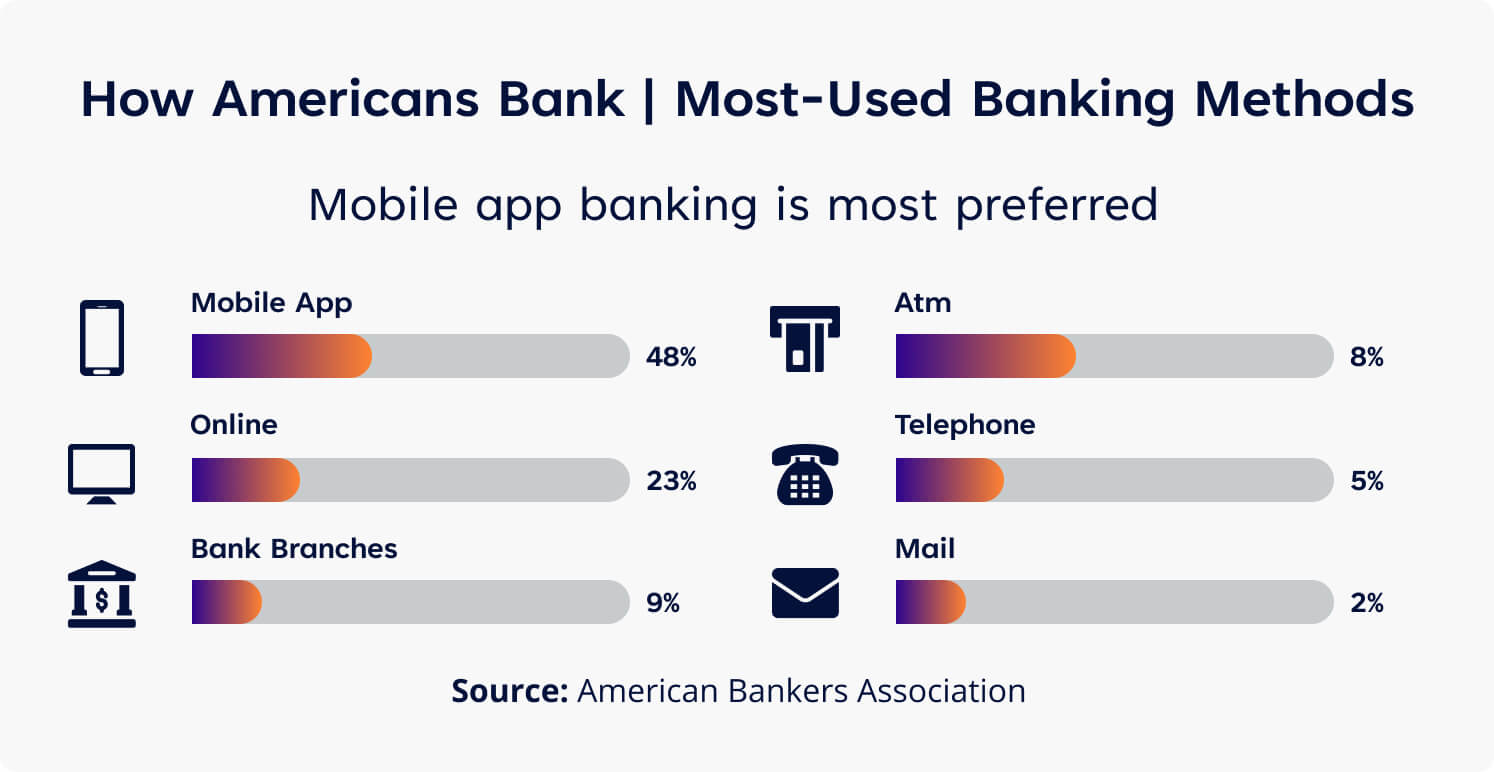
So, what’s holding banks back from transitioning to digital onboarding and offering much desired accessibility and convenience? Many institutions struggle with deploying digital solutions as they can be rigid and misaligned with their desired approach to commercial client engagement.
Furthermore, commercial onboarding is a complex process involving multiple stakeholders, extensive documentation, and complex product needs. As such, the prevailing view is that it is just too complicated for digital self-service. There’s also the belief that business banking requires a high-touch, relationship manager-led approach. For others, past digitization efforts have led to costly failures, contributing to a reluctance to invest in new solutions.
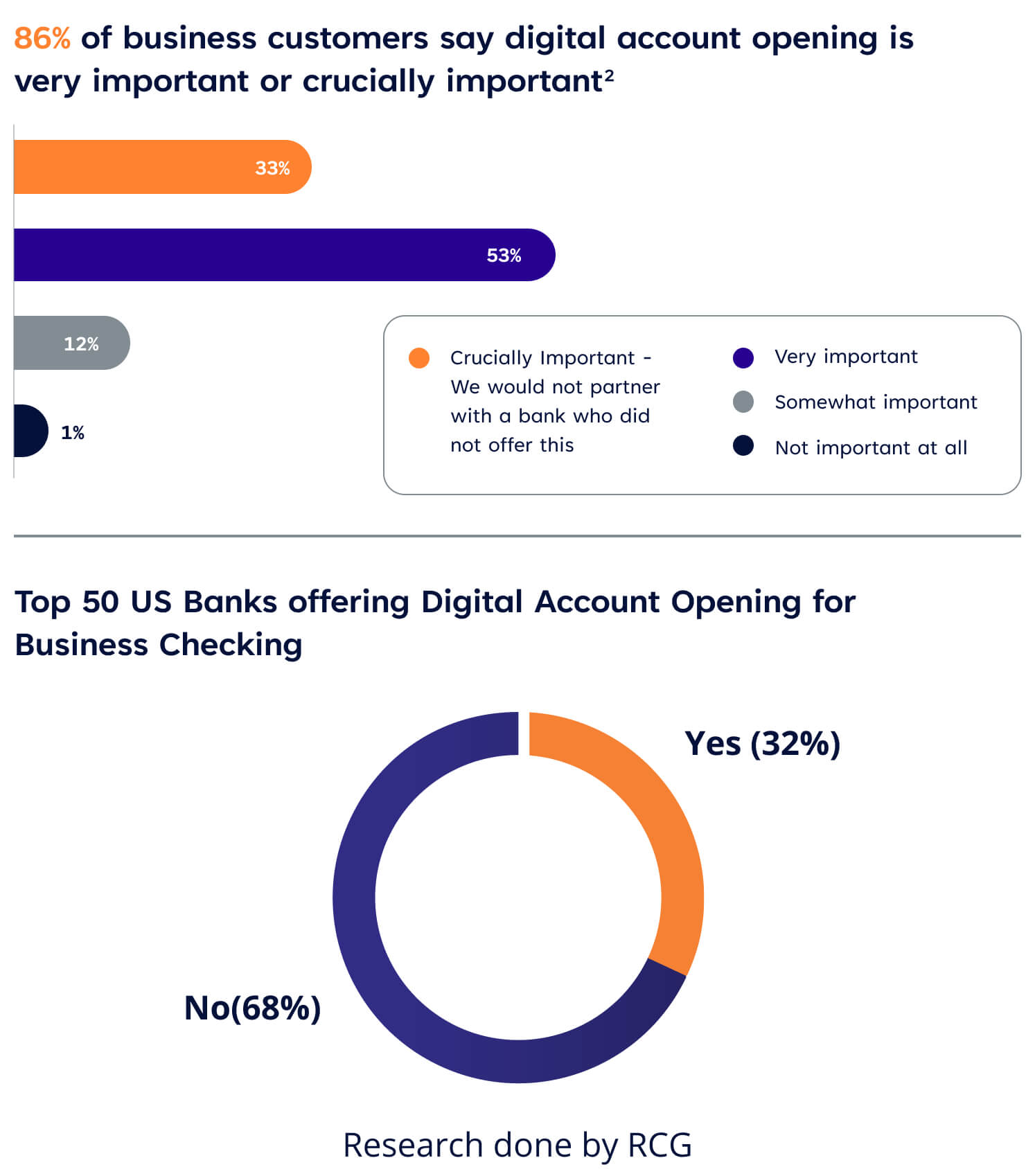
The Cost of Not Going Digital
The cost of not adopting digital onboarding in commercial banking can be significant. Traditional, manual onboarding processes are often slow, error-prone, and costly, resulting in these repercussions.
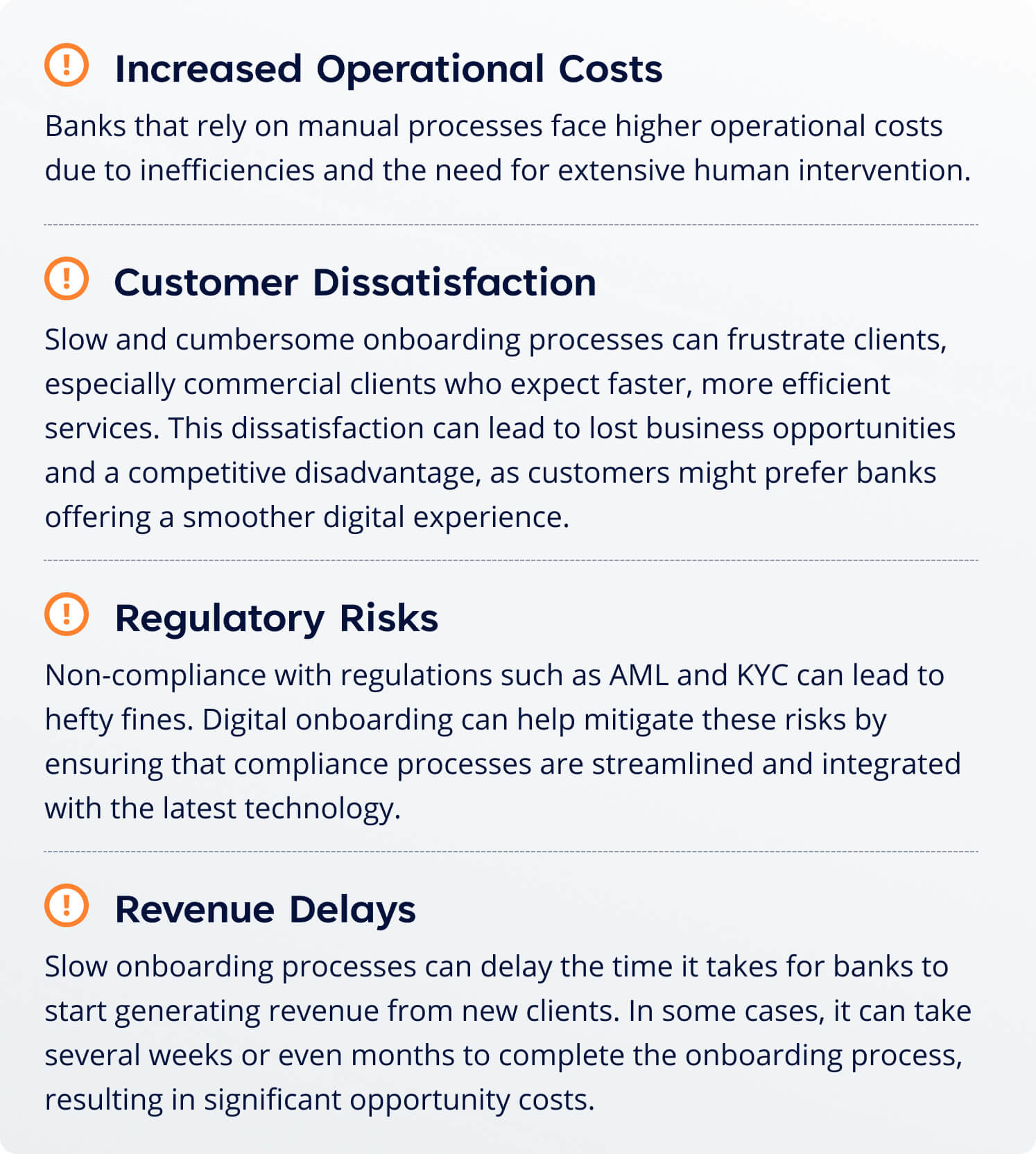
According to a Salesforce report, about 32% of businesses abandoned the onboarding process because it took too long. More than half of UK business owners who had opened a bank account in the last 12 months said they needed to go to a physical location, and print and sign paper documents. 51% said their bank needed more information after they opened the account—in some cases up to five more times3.
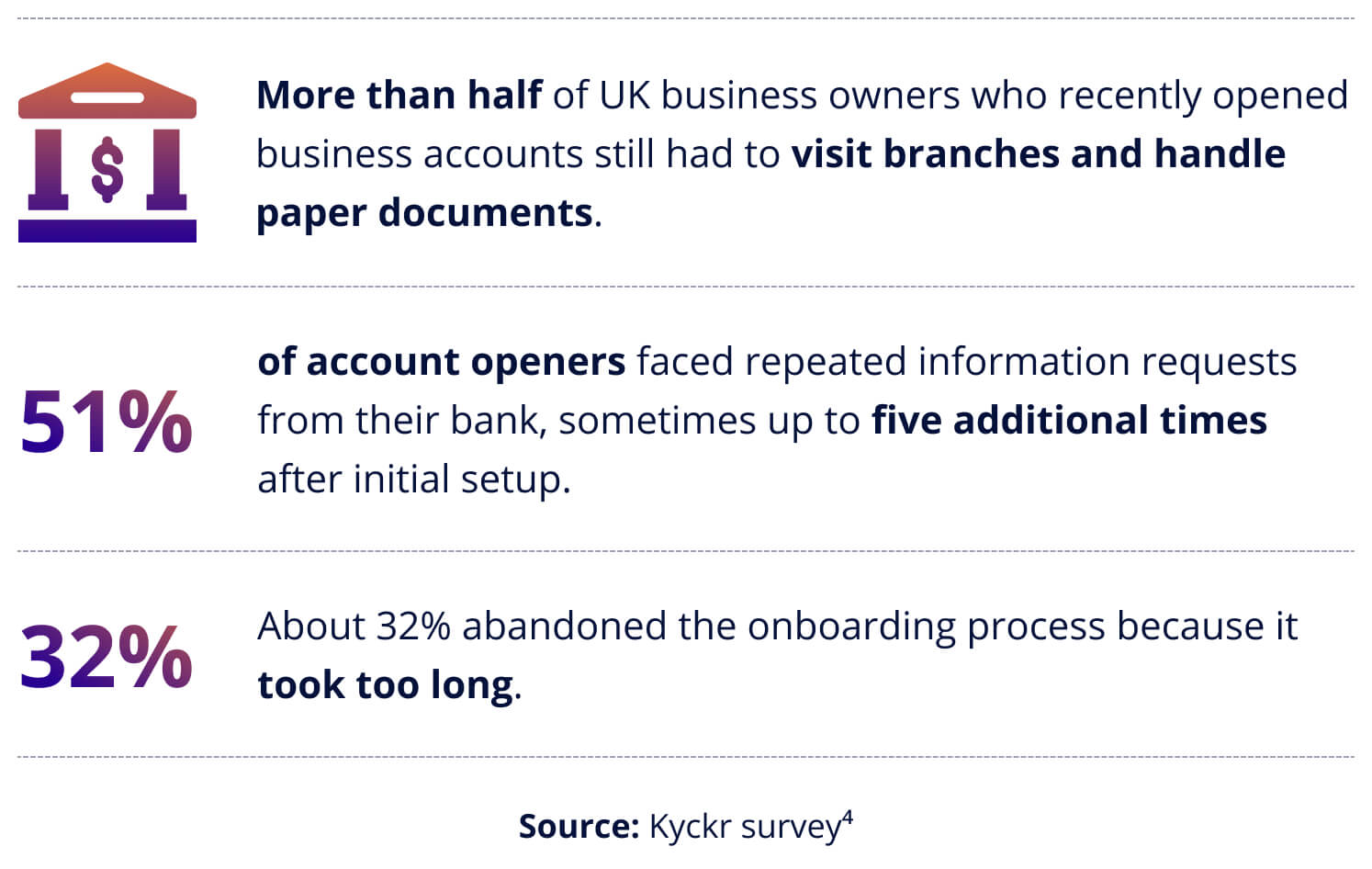
In today's fast-paced digital world, the cost of maintaining outdated onboarding processes in commercial banking is too high to ignore. Prioritizing digital onboarding is not just beneficial—it’s essential for staying relevant and meeting the expectations of modern businesses.
The Benefits of Making Onboarding Seamless
There’s a case study that perfectly illustrates the efficacy of digital onboarding, especially during times of crisis. During the bank failures of 2023, a business owner needed to transfer her business to a new bank immediately, but there was a major obstacle—her business partner was on vacation and unable to access the documents and paperwork required to open a new account.
Fortunately, the bank had recently implemented digital onboarding through RCG. Despite being miles away, the partner received the email, filled in their details, reviewed and accepted the necessary disclosures, and digitally signed the account agreements, all from the comfort of their vacation spot. By day’s end, the business account was open and ready to go.
This experience demonstrates just how transformative digital onboarding can be for banks and businesses that even in challenging situations, both can continue to operate smoothly. Digitizing commercial onboarding enhances customer experience and brand loyalty by catering to the needs of digital-first businesses with instant access and service availability. It also improves operational efficiency by automating manual processes, reducing onboarding costs, ensuring better regulatory compliance, and more.
Benefits of Digitizing Commercial Onboarding
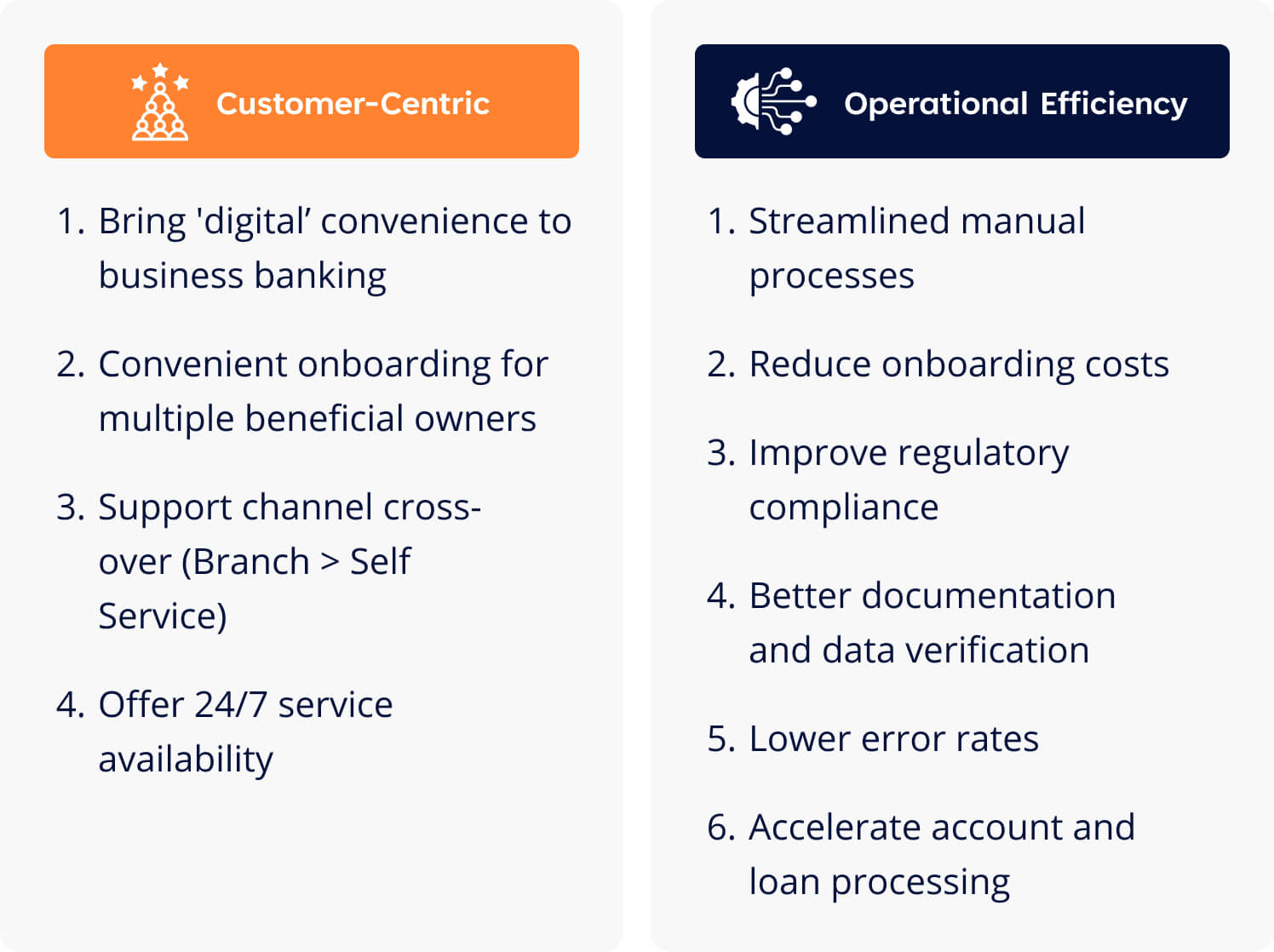
A Phased Approach for a Modern Experience
For any bank, transitioning from 100% manual processing to 100% digital is a large, complex, and risky proposition. As the inevitable shift to digital business banking continues, banks should implement digital onboarding in stages to lower risk and minimize disruption.
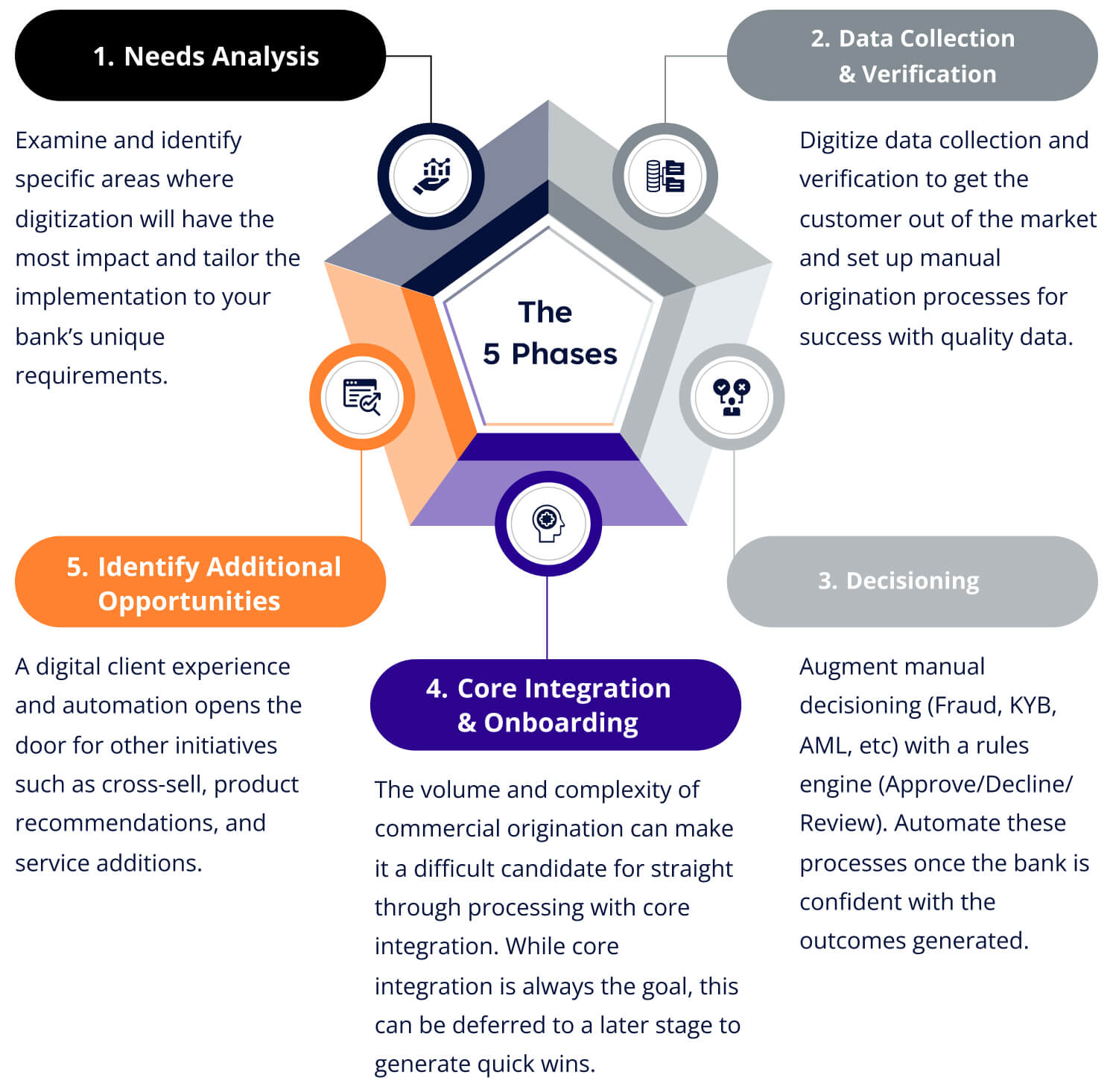
The journey to digital transformation in commercial onboarding is a strategic process that leverages data at every stage. As banks progress through these phases, they create a robust digital ecosystem that not only enhances onboarding but also opens doors for data-powered opportunities in cross-selling, product recommendations, and service enhancements. By embracing this phased, data-centric digitization strategy, banks can significantly reduce risks, optimize processes, and ultimately deliver a superior, tailored banking experience that meets the evolving needs of modern businesses.
Case Study: Increasing Deposit Growth by 9X
RCG successfully digitized the commercial onboarding process for a US regional bank, reducing the time to onboard a new business customer from two weeks to just 22 minutes. The bank achieved record-breaking deposit growth in 2024. With this success, the bank is now expanding its platform to include treasury management, lending, credit cards, and consumer deposits.
These are RCG’s implemented strategies that led to the bank’s success:
1. Narrow the Scope
The focus was on digitizing one product type, such as deposit accounts, rather than attempting to digitize everything simultaneously. By starting with a clear vision and a manageable scope, common pitfalls that often lead to failure were avoided.
2. Regard Onboarding as a Sales Funnel
Avoid the assumption that a customer who begins the application process with complete it regardless of the experience. A large regional bank made this mistake with the president stating, “If someone can’t open an account online, they can visit one of our 1,000 conveniently located branches to open an account.” However, when his team cross-referenced failed online account openings with branch account openings, only 13% of online failures resulted in branch visits.
Treat account opening like a sales funnel and optimize the conversion at each stage. Widen the funnel to ensure that the maximum number of people who click “Apply Now” finish the application.
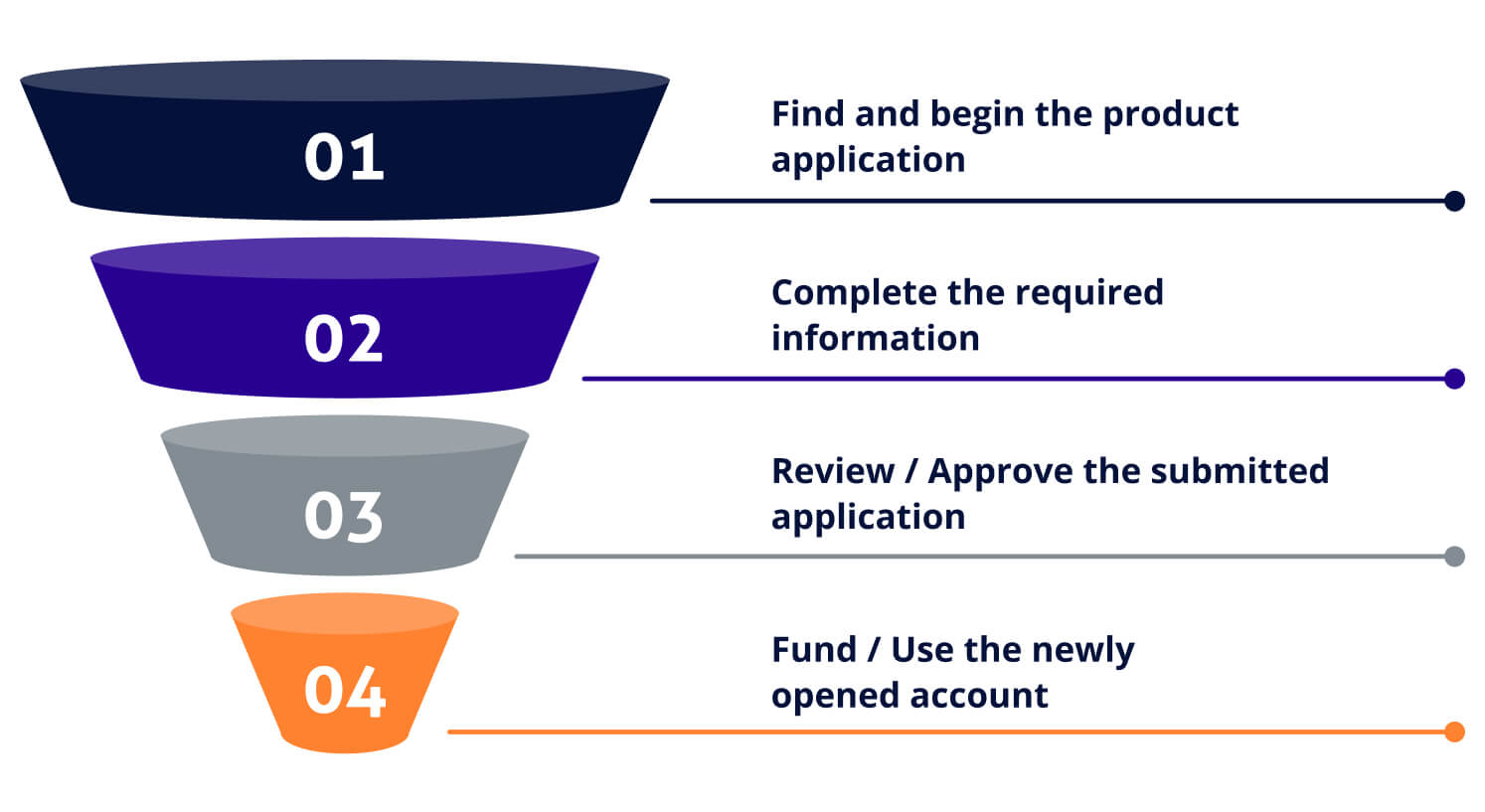
3. Design from Outside In
Many organizations begin their digitization with the core system in mind. They analyze the data the core will need to open an account and create a digital experience to mimic that. This approach is flawed. The design should be client-centric. Data can always be transformed to match core system requirements, but the core system was designed with bankers in mind, not clients, leading to a disconnect in user experience.
4. Separate Client Onboarding from Product Origination
Onboarding a client for any product requires compliance with KYB, KYC, AML, FINRA, etc. This process, referred to as client onboarding, is distinct from product origination, where the bank provides the business the specific banking product they requested.
The business was onboarded first by gathering essential information to ensure it met the bank's criteria. After successful onboarding, the desired product, such as a deposit account or credit card, was originated. This flexible approach allowed for gradual expansion to additional products over time.
This approach also supports product bundling, making it easier to onboard a client and originate one or multiple products in a single experience.
5. Categorize Fields and Ask Tough Questions Last
A challenging application experience can deter applicants. It’s important to ease applicants into the application process with easy questions like name, email, and address. This increases applicants’ investment in the process, making them more likely to complete the application even when the questions get harder.
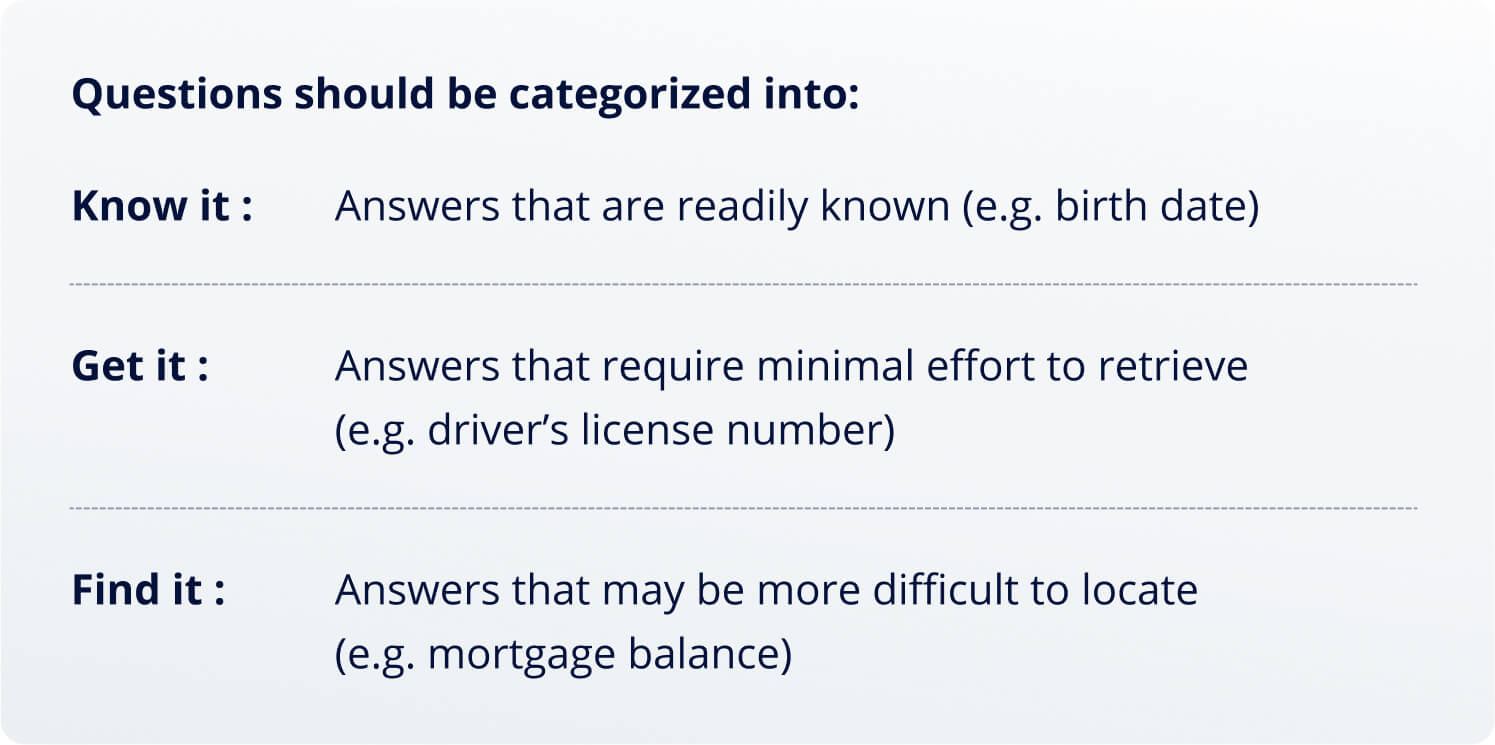
6. Ensure Questions Are Easy to Answer
Evaluate every field of information being requested. If a question is difficult or ambiguous, consider rephrasing it. For example, instead of asking "How long have you been in business (Years & Months)?" which can be cumbersome, ask if the business has been operating for "2 years or less," or offer a range (e.g., 0-12 months, 1-5 years, 5+ years). This simplifies the process for the applicant and reduces the likelihood of application abandonment.
7. Collect Business Details First
Banks have encountered issues where applications fail due to minor errors in business details, such as incorrect spelling of the business name. Implementing a business look-up tool at the start of the application process—similar to a Google address search—significantly improves the accuracy of business details, thereby increasing the success rate of verification processes with services like MidDesk and Lexis Nexis.
8. Digitize Workflow for Beneficial Owners
Capturing and verifying information about beneficial owners is one of the biggest challenges in digital onboarding of a business client. This challenge intensifies if the bank needs to verify other parties like signers or officers.
Adding a digital workflow to the application process allows the primary applicant to provide the names, emails, and phone numbers of the relevant parties. These individuals can then complete their details, accept disclosures, and eSign agreements securely online, without needing to visit a branch. This not only improves the client experience but also enhances regulatory compliance.
9. Support Save and Resume and Channel Crossover
It should not be assumed that clients have all the necessary information to complete an application in one sitting, whether online or in a branch. Allow clients to start the application in one channel and finish in another, or to save their progress and resume later. Recognizing that interruptions can occur ensures that clients are not lost during the application process.
10. Generate and Nurture Leads
Opening new bank accounts and processing loan applications are central to banking operations. However, these tasks may not be as important to business owners as managing their businesses or personal responsibilities. Acknowledge the likelihood of interruptions, save their application progress, and nurture them as leads. This approach not only provides a better client experience but also shows that the bank values their business.
11. Use Prefill Services Wherever Possible
There are a myriad of prefill services in the market, and many of them are used in retail banking. Address Lookup (Google, Melissa), Photo ID capture (Mitek, IDology), Phone Look-up (www.prove.com) are a few examples. Incorporating these services into your business onboarding enhances client experience and demonstrates that the bank is easy to do business with. It also helps improve data accuracy and regulatory compliance.
12. Support Digital Document Upload
Allow customers to upload digital copies of documents, but don't overlook the need to support device crossover (e.g., starting on a computer and continuing on a phone). This capability enables clients to use their smartphone cameras to capture digital copies of documents. Additionally, consider whether the document is truly necessary or if it can be sourced from another location, such as the Secretary of State for Articles of Incorporation. These considerations align with the goal of making the bank easy to do business with, which clients will recognize and appreciate.
13. Support eSigning
Digital signing of account agreements should be a standard feature, whether using DocuSign, Adobe Sign, or OneSpan (eSignLive). As clients expect this capability, its absence would be a significant oversight. Signing is often the final step in account opening or loan applications, so it is critical to ensure a smooth process.
14. Implement Mobile Responsive Design
Although most retail account openings occur on mobile devices, business account openings predominantly happen on desktops/laptops. However, given the increasing expectation to complete tasks on mobile phones, particularly for Beneficial Owners, Officers, and Signers, mobile responsiveness is crucial. Ensuring a mobile-friendly experience is a must.
15. Core Integration is Not Essential
At least in the early stages, the priority should be on enhancing the client experience with digital tools without requiring immediate integration with the core system.
While manual processing of digitally originated applications is not ideal, transitioning from "Manual Application > Rekeyed to Core" to "Digital Application > Rekeyed to Core" still represents significant improvement. The digital application offers more convenience, supports digital workflows for beneficial owners, enables document uploads, and improves data quality through validation services. This digital experience can later be integrated with the core system or automated using Robotic Process Automation (RPA) tools.
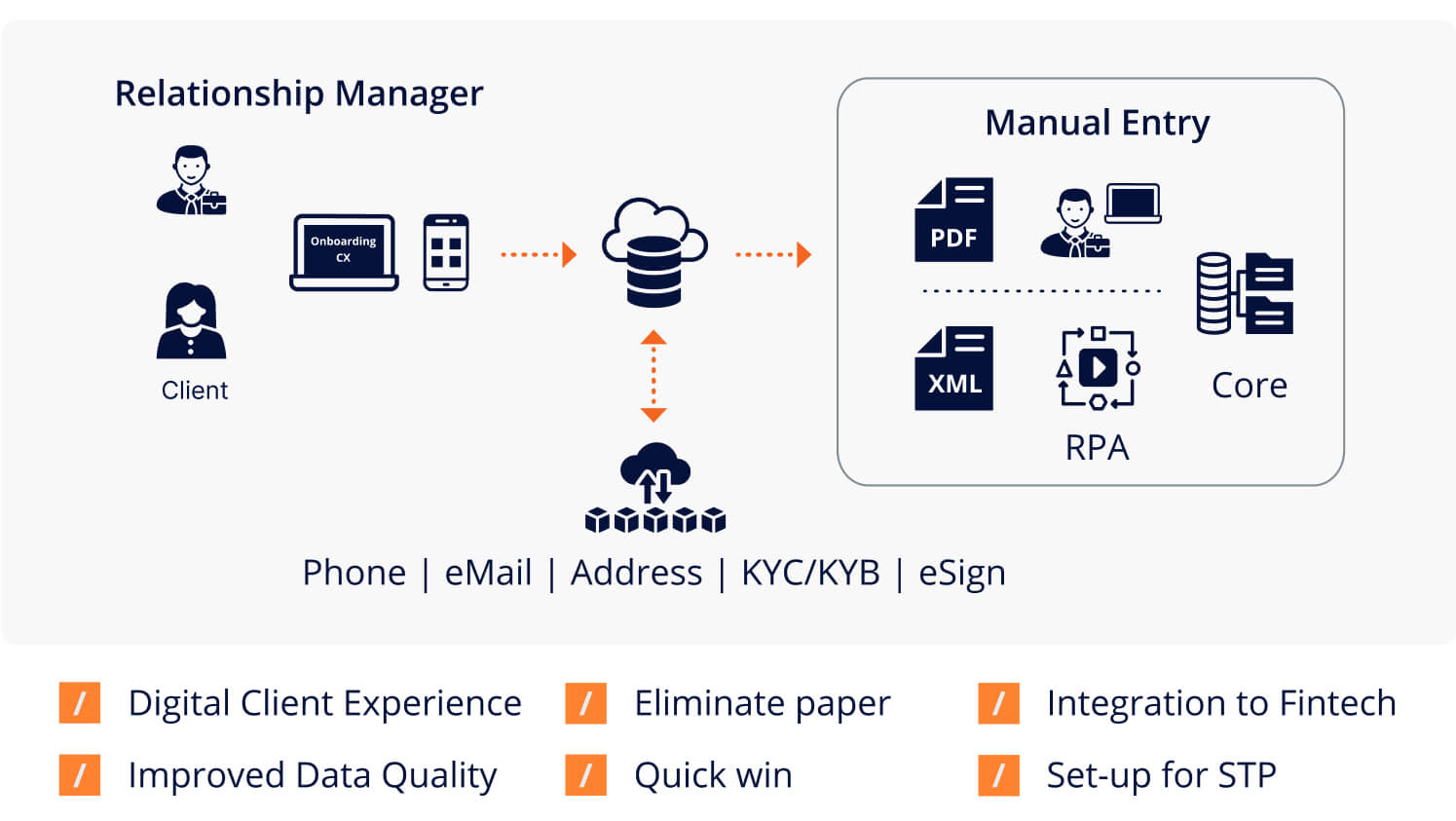
16. Leverage Fintech Solutions
Business onboarding (KYB) and owner verification (KYC) can be streamlined by utilizing fintech services like Alloy, MidDesk, and LexisNexis. These solutions accelerate the onboarding process and improve accuracy whilst simultaneously helping to protect the bank from attempted fraud.
Some of the Fintech services RCG gas worked with to improve KYB, KYC, AML and Fraud along with the cores and online banking systems integrated to are shown below:
17. Front-Load the Experience
Minimize the back-and-forth with clients by collecting as much information as possible upfront. Using digital resources like MidDesk to obtain Articles of Incorporation reduces the burden on business owners speeds up decision-making.
18. Continuous Improvement Post-Deployment
Once the digital application experience is live, allocate time and budget for at least one iteration. Feedback from bankers and clients will highlight areas for improvement, which can be prioritized in a backlog. Go-live is a milestone in the journey, not the final destination.
Conclusion
In today’s competitive landscape, the urgency for digital onboarding is undeniable. Banks must act swiftly to modernize their processes, reduce onboarding times, and meet the changing expectations of business customers.
RCG’s strategic partnerships with over 90 leading fintech providers enables us to seamlessly tailor solutions to each bank’s unique needs, ensuring a comprehensive digital transformation. And our experience integrating with core banking systems from FIS, Fiserv, Jack Henry and Temenos ensures the new commercial onboarding solution co-exists with the banks existing IT systems. By leveraging RCG’s innovative approach and fintech partnerships, banks can achieve rapid and effective digital transformation, driving growth and enhancing customer satisfaction.
Works Cited
- American Bankers Association, 2023 Preferred Banking Methods, 2023
- Temenos, How Banks Can Win Small Business Customers, 2018
- Salesforce, Onboarding is the Foundation of Digital Transformation, n.a.
- Kyckr, The State of Customer Onboarding in Corporate Banking, 2021
Download a PDF version of our Guide to Digital Onboarding.

